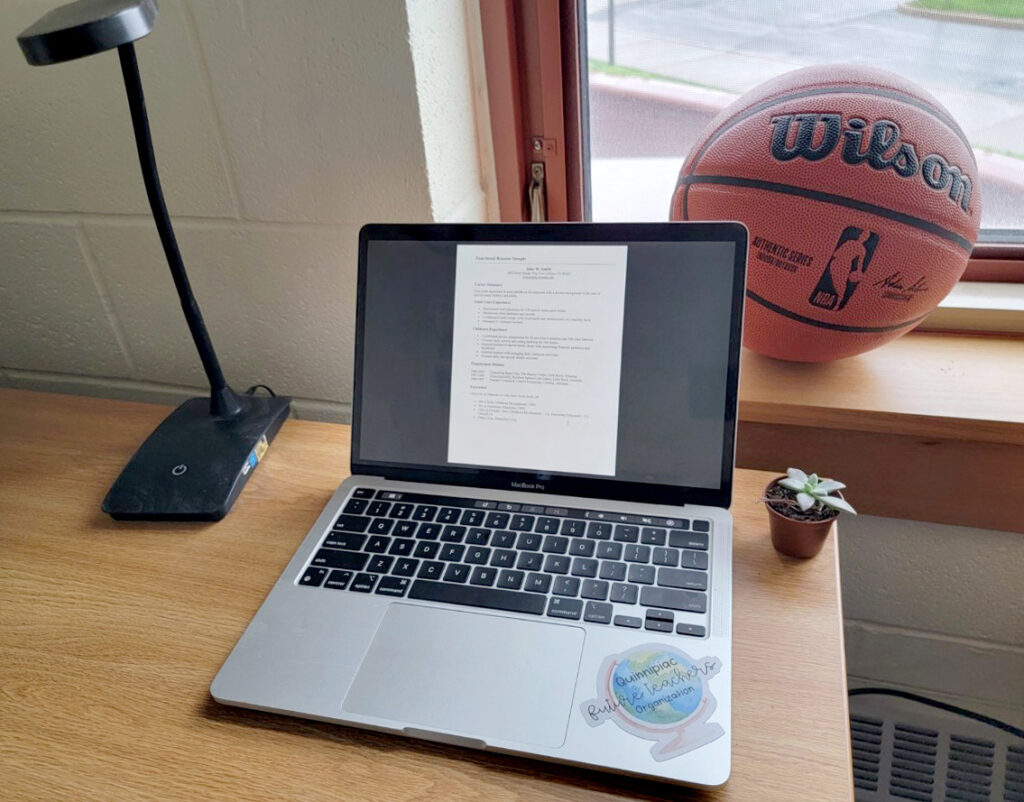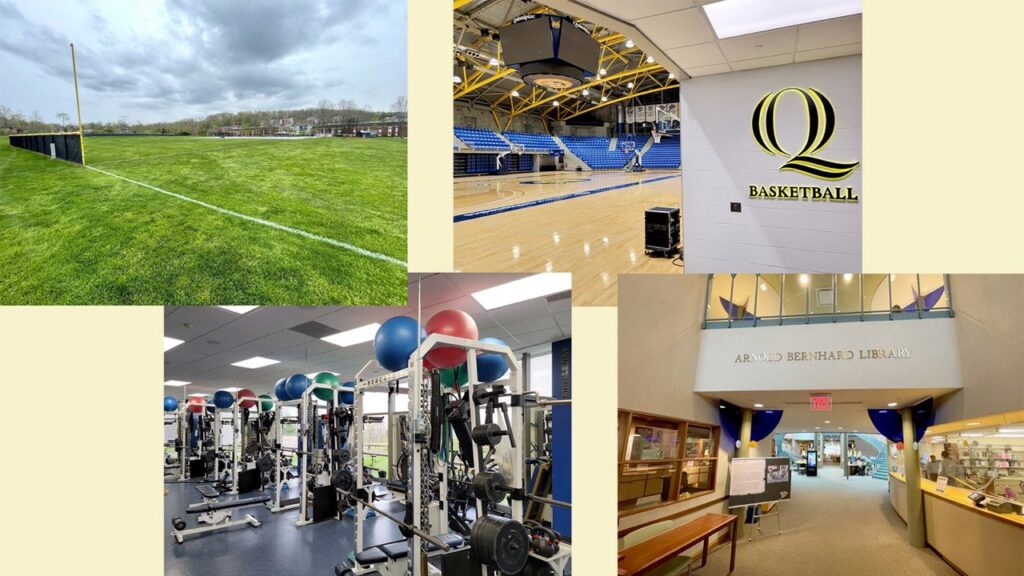
A common fear shared by senior college students preparing to graduate is losing the educational support system which they’ve had since kindergarten. For student-athletes, add to the picture elements such as the camaraderie of four years on a college team. Now, they’ve graduated and everything they’ve known has changed.
One goal of education is for the learner to develop transferable skills, defined as the abilities and skills that can apply from one role or occupation to another. As the name indicates, student-athletes are students, in addition to being athletes. The goal is to deliver each side of the equation the transferable skills necessary to support them whether they end up as professional athletes or not.
At Quinnipiac University, the student-athlete support system includes tools such as regular access to academic support, clear student development guidelines and access to a sports psychologist. There is guidance at every level along the way to fulfill the university’s mission statement to “…help guide and monitor Quinnipiac student-athletes through the process of achieving their academic, personal and professional goals.”
Walk-on athletes (a student who tries out for a collegiate team without recruitment or a scholarship,) and scholarship athletes (a student who receives a financial scholarship to play their sport,) have equal access to these tools. However, there’s a noted difference and advantage for walk-ons which comes from expectations and future goals.
“A walk-on would definitely be comparable to an entry-level position, which is ultimately what I’ll be doing in the workforce,” said Quinnipiac men’s basketball walk-on and ‘21, ‘22 graduate, Brendan Martin. “There’s different responsibilities as a walk-on compared to a scholarship player. You’re really just getting your foot in the door, working hard, giving your best effort and having a good attitude.”
Martin had dreams of playing Division I basketball as a child, but after graduating from high school without a scholarship, he found himself at Quinnipiac with his main goal to complete his degree in finance. After deciding on a whim to attend tryouts during his sophomore year in 2019, he impressed the coaching staff enough to make the team.
Martin played just 10 total minutes and scored five points across three seasons for the Bobcats, yet he accomplished his dream of playing Division I basketball while also completing Quinnipiac’s 3+1 undergraduate and graduate program in finance.
“In terms of academics, there will be people that have God-given talent in terms of smartness and intelligence. It’s the same way with sports,” Martin said. “But if you study every day you can yield the same amount of results as someone who is just kind of brilliant. The people that work the hardest will be the most successful.”
The minimum GPA requirement to maintain Division I NCAA eligibility hovers around 2.0. Despite the overall low standard, Quinnipiac student-athletes achieved a 3.67 GPA in 2019-2020, along with a 94 percent graduation success rate (GSR) in 2020. This compares to an average of 88 percent GSR in 2020 of all Division I schools according to the NCAA 2020 Division I Graduation Rate Trends.
“I’ve always felt that if a student is doing well in the classroom, they’re more inclined to do well on the field, because everything is aligned, everything is organized,” said Quinnipiac’s Assistant Athletic Director for Academic Support, Kristen Casamento. “We bring in students that understand the commitment of both school and sports. I think that’s really unique and special. It’s really important to be a successful program.”
One academic support program Casamento oversees is a summer bridge program, offered to incoming freshman student-athletes to familiarize them with the resources on campus.
“One of the first things we do in our summer bridge program is talk about the transition from high school to college and what that looks like both athletically and academically. A lot of them come in with that understanding already. But I think that’s really important,” Casamento said. “Our job is to make sure students are hitting all of the NCAA guidelines and are knowledgeable about them. There’s a whole 100 pages on it in the NCAA rulebook.”
The 2021-2022 NCAA Division I Manual contains 455 pages of outlined rules and expectations for everyone involved in athletics, including the university staff, faculty and student-athletes. On page 151, in the Academic Eligibility section, one rule directly mentions the overall goal of athletic support programs is to provide, “…an environment that recognizes and supports the primacy of the academic mission of its member institutions….”
Quinnipiac’s own 51-page 2021-2022 Student-Athlete Handbook, a response to the overall NCAA rulebook, includes an opening letter from Quinnipiac’s Director of Athletics, Greg Amodio. In the letter, Amodio says, “Because you are a varsity student-athlete here at Quinnipiac, you have an added responsibility to also act within the policies and procedures set forth by the NCAA, your sport’s conference, and the Department of Athletics…. We have high standards for excellence, and your goal should be to push yourself to be the best you can both academically and athletically.”
Quinnipiac’s athletic compliance office is charged with helping students stay connected to the 455-page rulebook.
“Unless you have your own company, there’s some set of standard rules or social norms that you’re going to have to be able to follow,” said Senior Associate Athletic Director of Compliance and Student Development, Shanna Alexander. “Students who come in as first-years might for the first time be in charge of making sure their own paperwork is done. Maybe by accident, an athlete broke a rule. It always ends up being a good conversation with the student. We use it as a learning tool.”
In both Quinnipiac’s and the NCAA rulebook, rules include academic requirements, travel policies and allowed/not allowed banned substances, among others. A theme is to check with supervisors before any sort of potential rule violation. The consequences for breaking rules could sometimes impact athletic eligibility.
“If you think about why the rules exist, it’s because institutions are part of a higher organization and student-athletes are part of an institution,” Alexander explained. “While maybe sometimes some of the rules don’t make a ton of sense in our context, the reason they exist is because there is a bigger context. I think that you find that in any organization.”
There is a reason for the development and growth of these support programs over the years as Quinnipiac has evolved with the times.
Randy Yanoff attended Quinnipiac as a liberal art major from 1991 to 1995. He was a walk-on baseball player at Quinnipiac from 1991 to 1993 until he quit the team before his Junior year.
“Baseball was a lot of time to commit while also trying to enjoy my time. I was in a fraternity and a bunch of different organizations. At a certain point, I just decided I didn’t want to keep playing. It wasn’t beneficial. We weren’t Division I so there were no scholarships,” Yanoff said. “I can guarantee the career services are a lot more intense and more helpful now than it was back in the day. Quinnipiac used to be a party school. There was less focus on education, but that might have been because of the students that were there at the time.”
Quinnipiac became a Division I school in 1998. Prior to that, they were a Division II school with limited resources and fewer scholarships to extend.
As their athletic department continued to grow, in 2021 Quinnipiac hired Devin Markle in the new role of clinical sport psychologist.
“There’s so much we don’t think about, such as performance anxiety, the pressure to win, perfectionism and a lot of other things,” Markle explained. “Just because they’re an athlete doesn’t mean they’ll turn off or on being on the court or the field.”
Markle encourages students to focus on the link between academics and athletics because the balance serves a role in their future.
“Being an athlete kind of exposes you to what you like, or don’t like, which translates into a future career. For example, if I have an athlete who really likes the team atmosphere, then I encourage them to continue to look for jobs in their future that mimic that,” Markle said. “You’re not supposed to hold hands, you’re supposed to give them the tools to go initiate it.”
Being a student-athlete gives students a second option for developing the necessary skills for a future career. Yanoff graduated with a liberal arts degree, but his career path ended up derived from transferable skills he got from playing collegiately as a walk-on athlete.
“Teamwork is the cliche, but that’s the transferable skill I learned from being in sports. You learn within jobs how to bring everyone up so that everyone does good,” Yanoff said. “When I owned a karate school and was coaching in karate, also when I ran a cell phone store and when I ran a car dealership, in all of those I had to get everyone to the best they could be, whether fighting or selling products. You learn how to get everyone better at what they do. You learn there’s a team aspect in everything.”
Two outcomes for student-athletes are either to continue with their sport professionally, or to go into a more conventional work world. For some, it’s obvious early on which path to take. With both outcomes, college is used as a way to develop skills for their future career—a primary goal of education.

A lot of young basketball players have professional hoop dreams. Some come true and some find form in another career.
“The basketball program had a word that kind of shaped up our program. Attitude,” Martin said. “Just coming in, having a positive attitude, doing what you’re supposed to do and holding yourself accountable, not only for yourself but for your teammates. That mindset will definitely be helpful in my working career.”
